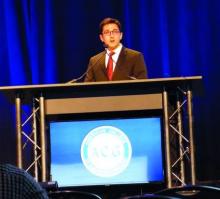PHILADELPHIA – There was a significantly higher adenoma detection rate when the withdrawal rate in the right colon was more than 3 minutes in patients undergoing colonoscopy, according to a recent presentation at the annual meeting of the American College of Gastroenterology.
Although adenomas precede colon cancer in approximately 70% of cases, and detection of adenomas is associated with 5% risk of dying from colorectal cancer, miss rates of adenomas are high in both sides of the colon and ideal withdrawal times are not known, Fahad F. Mir, MD, MSc, from the University of Missouri-Kansas City, said.
“Miss rates are high, especially in the right side of the colon. A colonoscopy offers protection in up to 80% of the left side of the patients but only up to 40%-60% in the right side of patients,” Dr. Mir stated in his presentation. “The quality standard now [for withdrawal time] is 6 minutes, so we hypothesized that adenoma detection rate is not the same if the right colon withdrawal time is equal to or more than 3 minutes, compared to less than 3 minutes.”
The abstract received an ACG Governor’s Award for Excellence in Clinical Research.
Dr. Mir and his colleagues performed a prospective, randomized, case-controlled study of 226 patients undergoing colonoscopy at three endoscopy centers in St. Luke’s Health System, Kansas City, who were aged at least 50 years and had not undergone colonic resections, emergent procedures, or were unable to consent because of mental status or language barrier. Patients were randomized to a control group (113 patients) in whom right colon withdrawal time was under 3 minutes and an intervention group (113 patients) in whom withdrawal time was 3 minutes or more.
There was a 33% adenoma detection rate in the 3 minute or more group, compared with 14% in the less than 3 minutes group (odds ratio, 3.0; 95% confidence interval, 1.62-5.64; P less than .001). Polyp detection rates were 49% in the 3 minutes or more group and 14% in the less than 3 minutes group (OR 5.1; 95% CI, 2.84-9.32; P less than .001). The optimal cut-off point was 3 minutes and 1 second with optimal sensitivity and specificity with an area under the curve of 0.73 (95% CI, 0.65-0.81; P less than .001) for optimal cut-off time for withdrawal from the right colon.
“There was a difference in fellow involvement, where fellows were more likely to be involved when the withdrawal time was more than 3 minutes as opposed to less than 3 minutes; the ADR [adenoma detection rate] was not different based upon fellow involvement,” Dr. Mir said.
The researchers noted similar rates of retroflexion between both groups and said there were no adverse events related to the study in either group. Limitations of the study included its unblinded design, data collection from multiple centers, and a higher rate of previous polyps in patients in the withdrawal in more than 3 minutes group.
Dr. Mir report no relevant conflicts of interest.
SOURCE: Mir FF et al. ACG 2018, Presentation 5.


